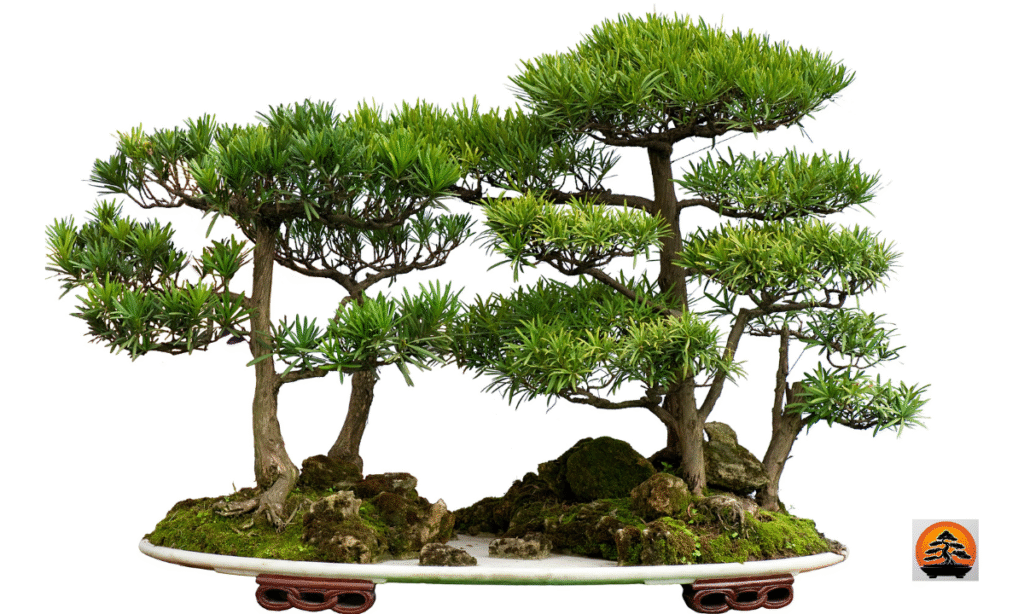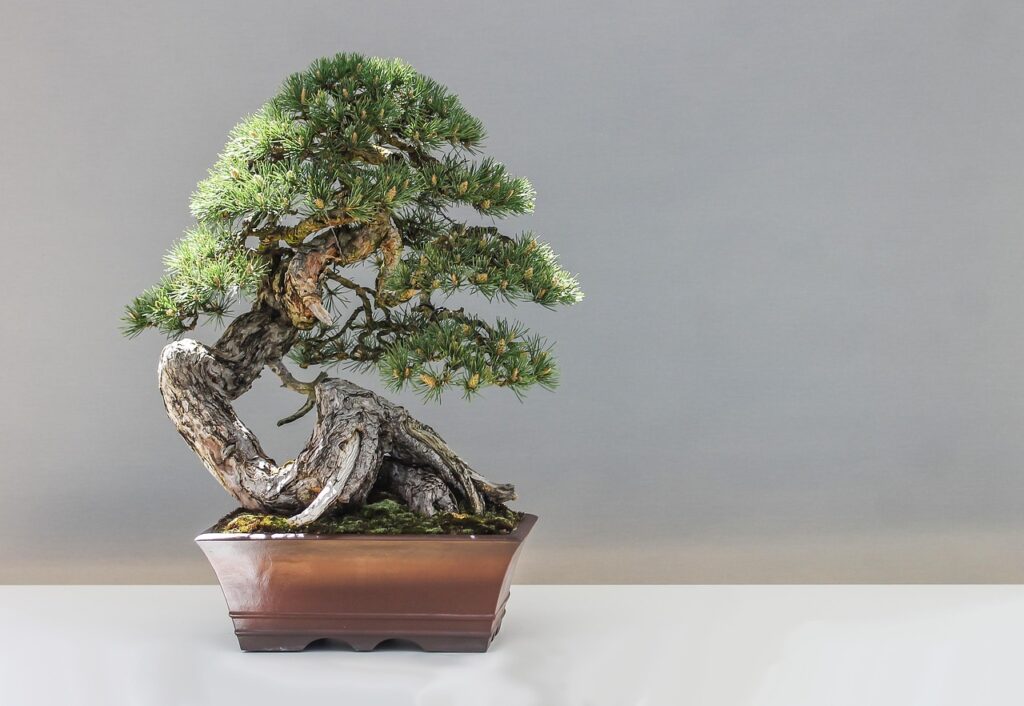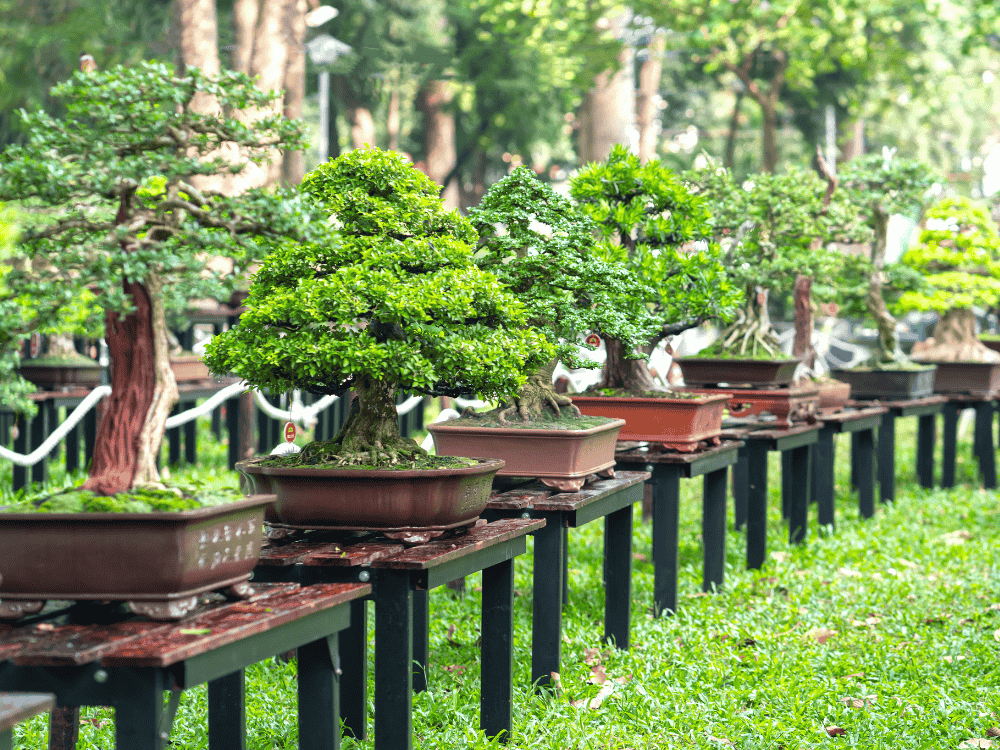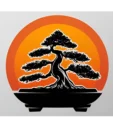Quick Answer:
Bonsai trees can live for hundreds of years with proper care—some specimens are over 1,000 years old. The lifespan depends on the tree species, care quality, and growing conditions. A Ficus bonsai might live 50-100+ years indoors, while outdoor species like pine, juniper, and maple bonsai can survive for centuries when given appropriate care.

Understanding Bonsai Tree Lifespan
How long does a bonsai tree live? The answer might surprise you: bonsai trees aren’t a special species with shortened lifespans. They’re regular trees kept small through careful cultivation. This means a bonsai has the potential to live just as long as—or even longer than—its full-sized counterparts in nature.
The key difference? Bonsai trees live in controlled environments where they receive consistent, expert care. With proper watering, quality soil, appropriate light, regular fertilization, and protection from harsh conditions, a bonsai can outlive trees growing in the wild.
Factors That Determine Bonsai Lifespan
Several critical factors influence how long your bonsai tree will live:
Tree species: Some species are naturally long-lived (pines, junipers, oaks), while others have shorter lifespans (tropical species like Ficus).
Care quality: Consistent watering, proper fertilization, appropriate light, and regular repotting directly impact longevity. Poor care can kill a bonsai in months; excellent care can extend its life for generations.
Growing conditions: Indoor versus outdoor placement, climate zone, seasonal protection, and environmental stress all play significant roles.
Genetics and health: Starting with a healthy specimen from quality stock gives your tree the best foundation for a long life.
Training methods: Gentle, gradual shaping preserves tree health better than aggressive styling that stresses the tree.

Bonsai Tree Lifespan by Species
Different species have vastly different natural lifespans. Here’s what you can expect from popular bonsai varieties:
Long-Lived Bonsai Species (100-1000+ Years)
Japanese White Pine (Pinus parviflora)
- Expected lifespan: 200-500+ years
- One of the most prestigious bonsai species
- Extremely hardy and long-lived with proper care
- Many famous specimens are 300-400 years old
Juniper Bonsai (Juniperus species)
- Expected lifespan: 100-300+ years
- Incredibly resilient to harsh conditions
- Popular beginner species that can become family heirlooms
- The famous Mansei-en juniper is over 1,000 years old
- Learn more in our Juniper Bonsai Care Guide
Japanese Maple (Acer palmatum)
- Expected lifespan: 100-300 years
- Stunning seasonal color changes
- Can be passed down through multiple generations
- Responds well to bonsai cultivation
Chinese Elm (Ulmus parvifolia)
- Expected lifespan: 50-150 years
- Versatile indoor/outdoor species
- Forgiving for beginners yet long-lived
- Develops beautiful bark texture with age
- Read our complete Chinese Elm Bonsai Care Guide
Trident Maple (Acer buergerianum)
- Expected lifespan: 100-200 years
- Develops impressive trunk character
- Hardy and adaptable
Medium-Lived Bonsai Species (50-100 Years)
Ficus Bonsai (Ficus retusa, Ficus benjamina)
- Expected lifespan: 50-100+ years
- Most popular indoor bonsai
- Can develop aerial roots and impressive trunks
- More forgiving than outdoor species
Jade Plant (Crassula ovata)
- Expected lifespan: 50-100 years
- Succulent bonsai perfect for beginners
- Extremely drought-tolerant
- Develops thick, tree-like trunks with age
- See our Dwarf Jade Bonsai Care Guide
Azalea Bonsai (Rhododendron indicum)
- Expected lifespan: 50-80 years
- Spectacular flowering display
- Requires specific care but worth the effort
- Learn more in our Azalea Bonsai Care Guide
Fukien Tea (Carmona reticulata)
- Expected lifespan: 30-60 years
- Popular indoor bonsai
- Produces small white flowers and berries
Bougainvillea Bonsai
- Expected lifespan: 20-40 years
- Tropical flowering species
- Stunning colorful bracts
- Worth growing despite shorter lifespan
- Check out our Bougainvillea Bonsai Care Guide
Serissa (Serissa japonica)
- Expected lifespan: 15-30 years
- Delicate white flowers
- More challenging to maintain
- Sensitive to environmental changes
- Read our Serissa Bonsai Care Guide

The Oldest Bonsai Trees in the World
Want proof that bonsai trees can live for centuries? These documented ancient specimens demonstrate the incredible longevity possible with expert care:
Ficus Bonsai at Crespi Bonsai Museum (Italy)
- Age: Over 1,000 years old
- Species: Ficus retusa
- Origin: China
- One of the oldest known bonsai trees in existence
- Stands over 10 feet tall
- Meticulously maintained for centuries
Sandai-Shogun-no-Matsu (Japan)
- Age: Over 500 years old
- Species: Japanese White Pine
- Current location: Tokyo Imperial Palace collection
- Survived the atomic bombing of Hiroshima
- A living testament to resilience and care
Shunka-en Bonsai Museum Collection (Japan)
- Multiple specimens over 300-400 years old
- Maintained by master Kunio Kobayashi
- Demonstrates what’s possible with generational care
Mansei-en Juniper (Japan)
- Age: Estimated 1,000+ years old
- Species: Juniper
- One of Japan’s national treasures
- Has been a bonsai for over 400 years
These ancient trees prove that with proper care, your bonsai isn’t just a houseplant—it’s a potential family heirloom that can be passed down through generations.

Why Do Some Bonsai Trees Die Young?
If bonsai can live for centuries, why do so many beginners lose their trees within the first year? Here are the most common causes of premature bonsai death:
1. Watering Problems (The #1 Killer)
Overwatering: Constantly soggy soil leads to root rot, fungal infections, and oxygen deprivation. Symptoms include yellowing leaves, mushy roots, and a foul smell from the soil.
Underwatering: Allowing soil to completely dry out kills fine feeder roots, causing leaf drop, browning, and eventually branch dieback.
Solution: Check soil moisture daily by pressing your finger into the soil. Water thoroughly when the top half-inch feels dry. Use quality bonsai soil that drains well while retaining adequate moisture.
2. Wrong Species for Your Environment
Keeping outdoor species like juniper, pine, or maple indoors will slowly kill them. These trees require winter dormancy with cold temperatures to complete their growth cycle. Without dormancy, they weaken and die within 1-2 years.
Conversely, tropical species like Ficus left outdoors in freezing temperatures will suffer frost damage and die quickly.
Solution: Research your specific species requirements. Indoor bonsai need tropical species; outdoor bonsai need temperate-climate trees that can handle your local weather.
3. Poor Soil Quality
Regular potting soil stays too wet in shallow bonsai pots, suffocating roots and creating anaerobic conditions that promote disease. Using the wrong soil is one of the fastest ways to kill a bonsai.
Solution: Always use proper bonsai soil mix with excellent drainage and aeration. Quality pre-mixed bonsai soil contains components like akadama, pumice, and lava rock that provide the perfect balance of water retention and drainage. Learn everything about soil composition in our comprehensive Bonsai Tree Soil Mix Guide.
Recommended: [Professional Bonsai Soil Mix on Amazon] – Pre-mixed, ready to use, suitable for most species.
4. Insufficient Light
Bonsai trees are not low-light plants. Indoor bonsai need bright, indirect light for 6-8 hours daily. Outdoor bonsai need direct morning sun. Insufficient light causes weak, leggy growth, leaf drop, and vulnerability to disease.
Solution: Place indoor bonsai near south or east-facing windows. If natural light is limited, supplement with a grow light during winter months.
5. Neglecting Fertilization
A tiny pot holds minimal nutrients. Without regular fertilization, your bonsai will slowly starve, showing stunted growth, pale leaves, and weakened immunity to pests and diseases.
Solution: Fertilize regularly during the growing season (spring through fall) with a balanced bonsai fertilizer. Reduce or stop fertilizing in winter when growth slows.
Recommended: [Organic Bonsai Fertilizer Pellets on Amazon] – Slow-release formula provides consistent nutrition for 2-3 months.
6. Skipping Repotting
As roots fill the pot over 2-3 years, soil becomes compacted and depleted. Root-bound trees can’t absorb water or nutrients effectively, leading to decline and eventual death.
Solution: Repot young bonsai every 1-2 years, mature specimens every 3-5 years. Use fresh bonsai soil and trim circling roots. For detailed guidance, read our article on Bonsai Pots: The Soul Beneath the Soil.

How to Help Your Bonsai Live Its Full Lifespan
Want your bonsai to outlive you? Follow these proven longevity strategies:
Master the Watering Technique
Check soil moisture daily—it’s a 30-second habit that prevents 80% of bonsai deaths. Water thoroughly when the top half-inch of soil feels dry, allowing water to flow from drainage holes. Water again after a minute to ensure complete saturation.
During hot summer months, you may need to water twice daily. In winter, watering frequency drops significantly. The key is observation and adaptation, not rigid schedules.
Pro tip: Use a moisture meter if you’re learning to read soil moisture levels. They’re inexpensive and take the guesswork out of watering.
Recommended: [Digital Bonsai Moisture Meter on Amazon] – Instant readings help prevent over and underwatering.
Use Quality Bonsai Soil
Never use regular potting soil for bonsai. Invest in proper bonsai soil mix or create your own blend using akadama, pumice, and lava rock. The extra cost pays dividends in tree health and longevity.
Quality soil provides three critical functions:
- Drains excess water quickly to prevent root rot
- Retains adequate moisture between waterings
- Allows air circulation to roots
When repotting, completely replace old soil rather than just topping it off. Old soil becomes compacted and loses its beneficial properties.
Provide Appropriate Light
Light is energy. Without adequate light, your bonsai can’t photosynthesize effectively, leading to weak growth and susceptibility to disease.
Indoor bonsai: Place within 3 feet of a bright window. South-facing windows provide the most light. Rotate your tree weekly for even light exposure on all sides.
Outdoor bonsai: Morning sun with afternoon shade is ideal for most species. Full-sun species like juniper can handle 6+ hours of direct light. Shade-loving species like azaleas prefer filtered light.
Fertilize Consistently
Think of fertilizer as vitamins for your tree. During the growing season (spring through fall), fertilize every 2-4 weeks with a balanced fertilizer diluted to half strength.
Use organic fertilizers like fish emulsion or pellet-form products that release nutrients slowly. Avoid over-fertilizing, which can burn roots and damage your tree.
Stop or significantly reduce fertilizing in winter when growth naturally slows.
Repot on Schedule
Don’t wait until your tree is obviously struggling. Proactive repotting every 2-3 years keeps your bonsai vigorous and healthy.
The best time to repot is early spring, just as buds begin to swell. This timing allows the tree to recover quickly and take advantage of the growing season.
When repotting:
- Remove about one-third of the root mass
- Completely replace old soil
- Trim circling roots that have reached the pot edges
- Use clean, sharp tools to make precise cuts
Recommended: [Bonsai Tool Kit with Root Hook on Amazon] – Essential tools for safe, effective repotting.
Protect from Extremes
Bonsai trees in small pots are more vulnerable to temperature extremes than trees in the ground. Protect them from:
- Hard freezes (move to unheated garage or cold frame)
- Intense summer heat (provide afternoon shade)
- Strong winds (can dry out foliage and damage branches)
- Sudden temperature changes (don’t bring outdoor trees inside)
Monitor for Pests and Disease
Weekly visual inspections catch problems early when they’re easy to treat. Look for:
- Spider mites (fine webbing, stippled leaves)
- Scale insects (brown bumps on stems)
- Aphids (clusters on new growth)
- Fungal issues (spots, mold, unusual discoloration)
Early intervention prevents minor issues from becoming tree-threatening problems.
Practice Patient, Gentle Styling
Aggressive pruning, wiring, or styling stresses your tree and can shorten its lifespan. Make major structural changes gradually over multiple seasons rather than all at once. Learn proper techniques in our How to Prune a Bonsai Tree guide.
Allow your tree to recover fully between styling sessions. A healthy, vigorous tree tolerates styling better and lives longer than a constantly stressed specimen.

Indoor vs. Outdoor Bonsai: Lifespan Differences
The environment where you keep your bonsai significantly impacts its potential lifespan.
Outdoor Bonsai Longevity
Outdoor bonsai species (juniper, pine, maple, oak) generally live longer when kept in their natural outdoor environment. These trees have evolved to experience seasonal changes, including winter dormancy.
Advantages of outdoor growing:
- Natural seasonal cycles promote healthy growth patterns
- Better air circulation reduces disease pressure
- Natural rainfall and humidity levels
- Room for larger root systems over time
- Easier to maintain long-term
Lifespan expectation: With proper care, outdoor bonsai can easily live 100-500+ years, matching or exceeding the lifespan of their full-sized counterparts.
Indoor Bonsai Longevity
Indoor bonsai (tropical species like Ficus, Jade, Chinese Elm when grown indoors) typically have shorter lifespans than outdoor species, but can still live 50-100+ years with excellent care. Learn which species thrive indoors in our guide to Best Indoor Bonsai Trees for Beginners.
Challenges of indoor growing:
- Lower light levels than outdoor conditions
- Dry indoor air, especially in winter
- Temperature fluctuations from heating/cooling
- More vulnerable to pest infestations
- Requires more attentive care
Lifespan expectation: Indoor bonsai commonly live 50-100 years with proper care. Some exceptional specimens have been documented at 150+ years. For detailed indoor care strategies, see our How to Care for an Indoor Bonsai guide.
The key: Choose tropical species specifically adapted to indoor conditions. Never try to keep outdoor species like juniper indoors—they will die within 1-2 years from lack of dormancy.
Can Bonsai Trees Live Forever?
Theoretically, yes—with perfect care and favorable conditions, some bonsai species could live indefinitely. Trees like bristlecone pines live 5,000+ years in nature, and there’s no biological reason a bonsai couldn’t approach similar longevity if maintained flawlessly.
However, practical challenges limit extreme longevity:
Human factors: Bonsai require consistent, knowledgeable care. If care quality drops or the tree is abandoned, even ancient specimens can die quickly.
Accidents happen: Storms, pests, disease, and unexpected events can damage or kill even well-maintained trees.
Accumulated stress: Years of root pruning, branch cutting, and living in confined spaces eventually take a toll on even hardy species.
The realistic outlook: With generational care and expert maintenance, your bonsai can easily become a family heirloom lasting 100-300+ years. That’s multiple human lifetimes—close enough to “forever” for most purposes.
Starting Your Bonsai Legacy: Setting Up for Success
If you want your bonsai to outlive you and become a family treasure, start with these foundational steps:
Choose Long-Lived Species
Select species known for longevity and resilience:
- Best outdoor choices: Japanese White Pine, Juniper, Japanese Maple, Trident Maple
- Best indoor choices: Ficus (especially Ficus retusa), Chinese Elm, Jade Plant
Avoid short-lived or finicky species for your first tree. Save those for when you have experience. Our guide on How to Choose Your First Bonsai Tree walks you through the selection process, and you can explore all options in our Types of Bonsai Trees article.
Invest in Quality Tools
Good tools make care easier and prevent accidental damage that shortens tree lifespan. Essential tools for longevity:
Bonsai scissors – For precise, clean cuts that heal quickly Root hook – For gentle repotting without tearing roots Wire cutters – For shaping without damaging bark Moisture meter – For accurate watering decisions
Recommended: [Complete Bonsai Tool Set on Amazon] – Everything beginners need for proper long-term care. See our full recommendations in Best Beginner Bonsai Tools.
Use Premium Soil from Day One
Soil quality directly correlates with tree health and longevity. Don’t cut corners here. Quality bonsai soil costs more than potting soil, but your tree will live decades longer because of it.
Look for soil mixes containing:
- Akadama (Japanese clay granules)
- Pumice or lava rock
- Small percentage of organic matter
Recommended: [Premium Akadama Bonsai Soil on Amazon] – Professional-grade substrate used in Japanese bonsai gardens.
Keep a Care Journal
Document watering, fertilizing, repotting, and any issues you encounter. Over years and decades, these records become invaluable for understanding your tree’s patterns and needs.
Note seasonal changes, growth spurts, and how your tree responds to different care approaches. This knowledge helps you—and future caretakers—keep the tree thriving.
Plan for Succession
If you want your bonsai to outlive you, teach family members or friends how to care for it. Include your tree in estate planning. Designate a knowledgeable caretaker who appreciates the tree’s value.
Some bonsai enthusiasts donate ancient specimens to botanical gardens or bonsai museums, ensuring expert care continues after they’re gone.

Common Questions About Bonsai Lifespan
Do bonsai trees live longer than normal trees?
Bonsai trees have the same genetic lifespan as full-sized trees of the same species. However, bonsai often live longer because they receive consistent expert care, protection from harsh weather, and freedom from competition for resources. A pine bonsai can live just as long as a pine tree in a forest—sometimes longer due to superior care.
How old should a bonsai tree be before you buy it?
For beginners, look for bonsai trees that are 3-7 years old. These “pre-bonsai” or starter trees have established root systems and basic branch structure but are young enough to be affordable and forgiving of beginner mistakes. Trees younger than 3 years require expert care. Trees older than 20-30 years become exponentially more expensive due to the time invested in their development.
Why did my bonsai tree die so quickly?
Most bonsai deaths occur from watering problems (over or underwatering), keeping outdoor species indoors without dormancy, insufficient light, or poor soil quality. Less commonly, pest infestations, disease, or severe root damage during repotting can kill trees quickly. The good news: almost all causes of premature death are preventable with proper education and consistent care. Check out our Beginner Bonsai Mistakes guide and Why Is My Bonsai Dying and How to Save It for recovery strategies.
Can you revive a dying bonsai tree?
It depends on how far gone the tree is. If you still see green under the bark and flexible branches, there’s hope. Adjust watering immediately, ensure proper light, and avoid further stress. Remove any dead branches. Many bonsai can recover from neglect if you catch problems before complete root death. However, once all foliage has dropped and branches are brittle and brown, the tree has likely died.
How do I know how old my bonsai tree is?
Unless you grew the tree from seed or cutting, determining exact age is difficult. Some indicators include:
- Trunk thickness (thicker = older, generally)
- Bark texture and maturity
- Branch ramification (fine branching takes years to develop)
- Documentation from the seller or previous owner
- Growth ring counting (requires cutting, so not practical for living trees)
Many bonsai sellers provide approximate age. Remember, a tree’s age matters less than its health and artistic development.
Final Thoughts: Growing a Living Legacy
How long does a bonsai tree live? With proper care, your bonsai can outlive you—becoming a living legacy that connects generations. The 1,000-year-old Ficus at the Crespi Museum isn’t just a tree; it’s a testament to centuries of devoted caretakers who understood that bonsai cultivation is an act of faith in the future.
Your bonsai journey begins with a single tree and consistent daily care. Water thoughtfully. Provide quality soil and appropriate light. Fertilize during growing seasons. Repot when needed. Protect from extremes. These simple practices, repeated season after season, year after year, create the conditions for extraordinary longevity. Our Bonsai Tree Care for Beginners FAQ answers common questions to help you build these good habits.
The tree you care for today might grace your grandchildren’s homes decades from now. It might become a family treasure with stories spanning generations. That humble juniper or ficus sitting on your windowsill has the potential to outlive empires—if you give it the care it deserves.
Start with the fundamentals, invest in quality tools and materials, and commit to learning as you grow alongside your tree. The result isn’t just a beautiful miniature tree—it’s a living connection to the past and a gift to the future. Explore our complete Bonsai Care section for ongoing guidance.
Ready to start your bonsai legacy? Choose a long-lived species, gather quality tools and soil, and begin the rewarding journey of keeping a tree alive for generations to come. Whether you’re buying your first bonsai or selecting from store-bought bonsai trees, understanding longevity will help you make the best choice for your circumstances.
Start Your Journey with the Right Tools
Ready to level up your toolkit? Check out our detailed roundup: Best Beginner Bonsai Tools.
Free Download: Master Mori’s Starter Pack
Need a cheat sheet? Grab your Beginner Bonsai Starter Pack, filled with:
Species suggestions
Watering and light charts
Mori’s quotes and tool checklist
Note: This article contains affiliate links. If you purchase through these links, we may earn a small commission at no additional cost to you. We only recommend products we believe will genuinely help your bonsai thrive.
How Long Does a Bonsai Tree Live FAQ
How long does a bonsai tree live on average?
Bonsai trees typically live 50-100+ years with proper care, though many species can survive for centuries. The average lifespan depends on the species: indoor tropical bonsai like Ficus live 50-100 years, while outdoor species like juniper, pine, and maple can live 100-500+ years. The oldest documented bonsai trees are over 1,000 years old. With consistent watering, appropriate light, quality soil, and regular maintenance, your bonsai has the potential to become a family heirloom passed down through multiple generations.
Do bonsai trees live longer than normal trees?
Yes, bonsai trees often live longer than their full-sized counterparts in nature. This is because bonsai receive meticulous daily care, protection from harsh weather, consistent watering and fertilization, and freedom from competition with other plants. A bonsai pine might live 300-500 years while wild pines average 100-200 years. The controlled environment and expert care provided to bonsai creates ideal conditions for longevity. However, bonsai have the same genetic lifespan as full-sized trees of their species—they simply benefit from superior care that helps them reach their maximum potential age.
What kills bonsai trees most often?
Watering problems kill more bonsai trees than any other factor. Overwatering causes root rot, fungal infections, and oxygen deprivation, showing as yellowing leaves and mushy roots. Underwatering leads to dried-out roots, brown crispy leaves, and branch dieback. Other common killers include keeping outdoor species indoors without winter dormancy (especially junipers and pines), insufficient light exposure, using regular potting soil instead of proper bonsai soil mix, neglecting to fertilize during growing seasons, and skipping repotting when roots become bound. Nearly all premature bonsai deaths are preventable with proper education and consistent care habits.
Can you keep a bonsai tree alive forever?
While bonsai trees cannot live literally forever, they can live for many human lifetimes—potentially 500-1,000+ years with generational care. Some species like bristlecone pine can theoretically live thousands of years. The key is passing the tree to knowledgeable caretakers who maintain consistent care standards. Many ancient bonsai in Japan have been carefully maintained by families for 6-10 generations. However, practical challenges like accidents, disease, environmental disasters, or gaps in care can end even well-maintained trees. With proper succession planning and documentation of care requirements, your bonsai can outlive you by centuries.
How old should a bonsai be when you buy it?
For beginners, purchase bonsai trees that are 3-7 years old. These “starter bonsai” or “pre-bonsai” have established root systems and basic branch structure but remain affordable ($30-150) and forgiving of beginner mistakes. Trees younger than 3 years require expert care and patience. Trees older than 10-15 years become significantly more expensive ($200-2,000+) and less tolerant of care errors. Very old specimen bonsai (50+ years) can cost thousands to millions of dollars and should only be purchased by experienced enthusiasts. Starting with a moderately aged tree gives you the best learning experience while still allowing decades to develop your skills and bond with your tree.
New to Bonsai? Subscribe to our newsletter and download our free guide. Master Mori’s Will Show You the Way



